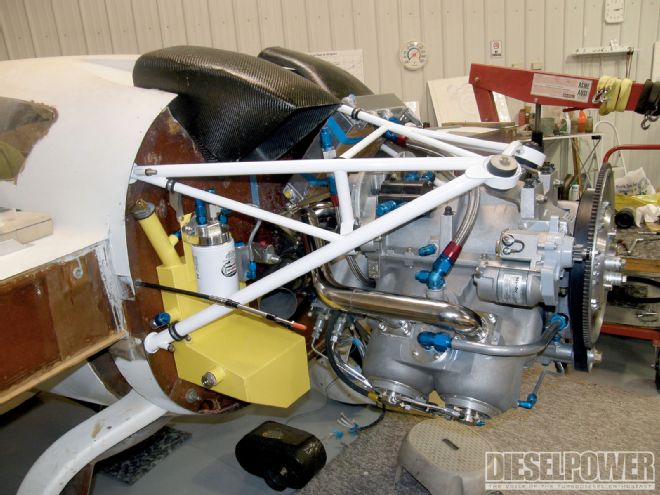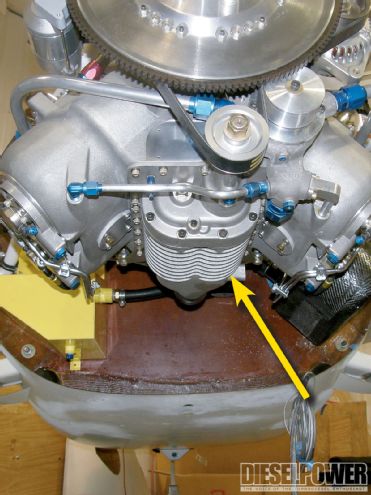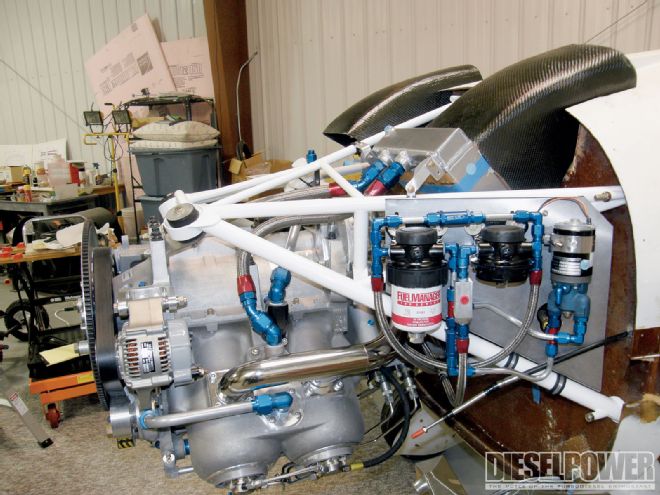It is only a matter of time before the high-octane, leaded, aviation gasoline used in small aircraft becomes unavailable. Besides the environmental reasons, aviation gasoline is being phased out, as the United States military has vowed to switch to kerosene-based fuels by 2010. A small company in Racine, Wisconsin, named DeltaHawk saw the writing on the wall, and when it couldn't find a proper diesel aviation engine to power its record-setting endurance plane, it decided to build its own. DeltaHawk's two-stroke diesel engine sparked the interest of aviation companies large and small around the world. For example, a New Zealand helicopter manufacturer sourced a DeltaHawk diesel powerplant for its unmanned craft that's able to rescue Himalayan climbers stuck above 30,000 feet.

| A. Injectors
B. Starter
C. Oil pump
D. Injection pump
E. Turbo
The U.S. military and Boeing have also expressed interest in building fleets of unmanned DeltaHawk-powered attack, rescue, and reconnaissance helicopters. These choppers would be satellite-controlled, quiet, and nearly invisible to heat-seeking missiles, since this diesel engine produces little waste heat. The diesel-powered fighters will sip fuel and be able to stay in the air for long periods of time.

| Diesel Power asked, "How is a diesel aviation engine different from a diesel automotive engine? DeltaHawk answered, "We are restricted to 2,700 rpm so that the tips of the propeller do not exceed the speed of sound. Airplane engines must be many orders of magnitude more reliable than an automobile engine for obvious reasons. Not so obvious is that an aviation engine must be designed with a much different power duty cycle. An automobile engine spends most of its time loafing-short bursts of high power for acceleration followed by long periods of low-power cruising. An aviation engine must develop rated power on a continuous basis. And while weight is important in automobiles, low weight is critical in aviation."
DieselHawk's Performance and Reliability Facts
1. Lower part count and fewer potential leakage points than the current four-cylinder gasoline-powered aircraft engines
2. No cam or valvetrain
3. Fully doweled, four-bolt main bearing caps with 12 studs
4. No ignition system and no electromagnetic interference
5. Burns 75 percent less fuel than a turbine engine
6. If turbo fails, the limp-home mode still provides 100 hp
7. Does not burn aviation gasoline (which contains four times more lead than leaded automotive fuels did when they were made illegal)
8. The DeltaHawk's brake-specific fuel consumption is 0.39, versus the Lycoming IO-360 gasoline engine's 0.42 rating
9. The DeltaHawk engine burns 11.2 gallons per hour at 100 percent power
10. The Lycoming I0-360 (gasoline engine) burns 16 gallons per hour at 100 percent power
Aero-Spec: DeltaHawk V-4 Aviation Turbodiesel
Built by: DeltaHawk
Type: 90-degree V-4, two-stroke compression ignition
Mounting configuration: Upright, inverted, or vertical
Air intake: Supercharged (DeltaHawk roots style) and turbocharged (Kelly Aerospace)
Lubrication: Oil pump and external air-oil separator with sump
Cooling: Liquid cooled
Fuel injection: Four mechanical injection pumps-if one pump should fail in flight the engine still runs, although with less power
Power: 160, 180, or 200 hp at 2,700 rpm
Fuel economy: 0.39 lb per hp/hr
Engine weight: 327 pounds
Fuel type: Jet-A, Jet-A1, JP-5, JP-8, Diesel #1, Diesel #2, and biodiesel
Electrical: 60-, 100-, or 200-amp alternator with 28-volt starter


